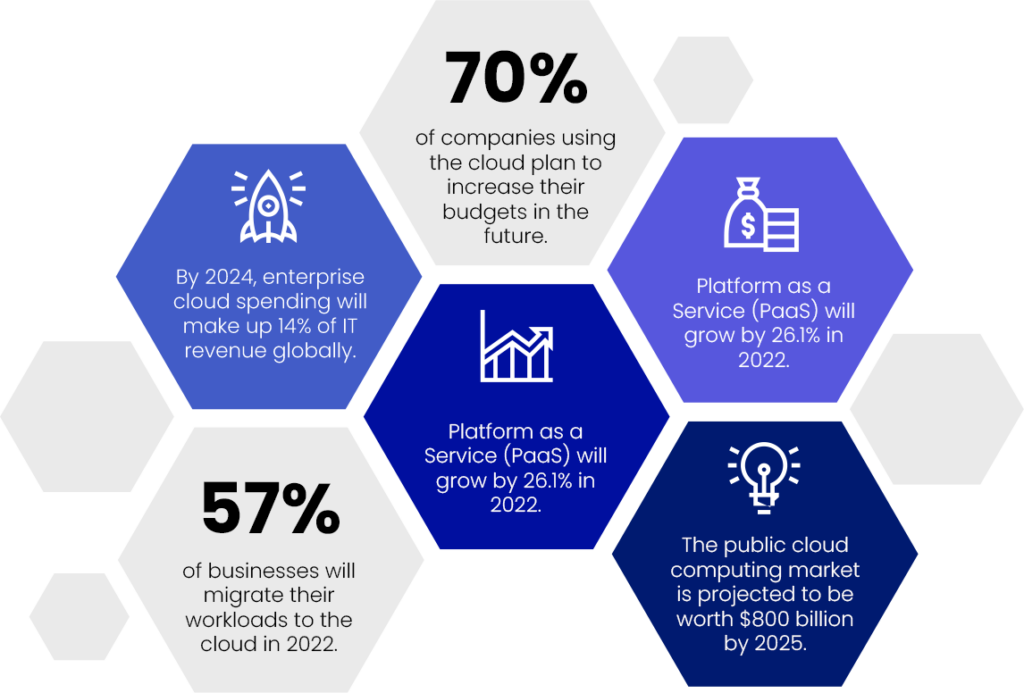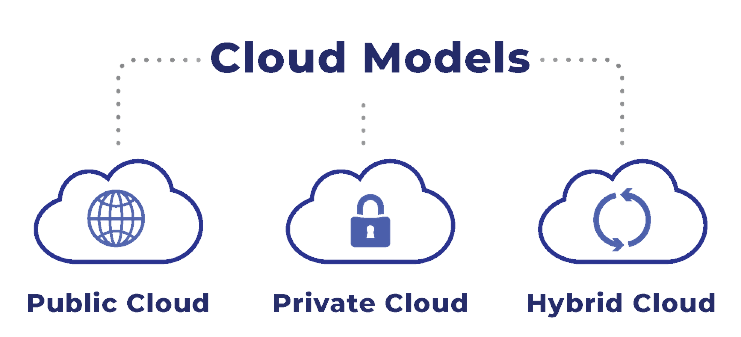Table of Contents
ToggleIn today’s market, the cloud is a well-talked-about technology, but you may be wondering, what does cloud computing really mean? Is cloud computing expensive? My small business doesn’t have the infrastructure or bandwidth to be able to migrate to the cloud, or does it? We will get into the nitty-gritty of how your small business can not only benefit from the cloud, but save money from transitioning.
What is Cloud Computing?
Cloud computing is a service using a network of remote servers hosted on the internet to store, manage and process data, instead of a traditional local server or a personal computer, which requires no direct management by a user. The most common uses for ‘the cloud’ are secondary storage of business or personal files, data backup for disaster recovery, online collaboration of tasks through shared documents on one platform and using software on a subscription (often called software-as-a-service or SaaS). Businesses typically pay only for cloud services they use, helping you lower your operating costs, run your infrastructure more efficiently, and scale as your business needs change.
Cloud computing provides an easy and secure way to archive data without investing in an on-premises infrastructure.
Will Cloud Computing Continue to Grow?
 In the past few years, thousands of companies have moved their infrastructure to the cloud. Soon, there will be only a small percentage of businesses still operating on a physical server. Check out these statistics from TechJury.net on cloud adoption in 2022.
In the past few years, thousands of companies have moved their infrastructure to the cloud. Soon, there will be only a small percentage of businesses still operating on a physical server. Check out these statistics from TechJury.net on cloud adoption in 2022.- The public cloud computing market is projected to be worth $800 billion by 2025.
- By 2024, enterprise cloud spending will make up 14% of IT revenue globally.
- Platform as a Service (PaaS) will grow by 26.1% in 2022.
- 70% of companies using the cloud plan to increase their budgets in the future.
- 57% of businesses will migrate their workloads to the cloud in 2022.
- Cloud Computing is 40x cost-effective compared to in-house IT systems for SMBs.
Public Cloud vs. Private Cloud vs. Hybrid Cloud: How to Choose?

The cloud is not one size fits all, there are several different models, types, and services that have evolved to help offer the right solution for your needs. First, an IT leader should determine the type of cloud architecture or cloud deployment that their cloud services will be implemented on. There are 3 cloud options for deploying cloud services on a public cloud, private cloud, or hybrid cloud.
1. Public Cloud
This cloud computing model implies making digital assets on the cloud publicly available over the internet. Facebook, Google and LinkedIn are all examples of public services. Public clouds are either free for customers or offered on a subscription basis (i.e., PaaS, SaaS). The public cloud is owned and operated by third-party cloud service providers, like Microsoft Azure. Third-party cloud service providers deliver their computing resources, like servers and storage, over the Internet. In a public cloud, all hardware, software, and other supporting infrastructure are owned and managed by the cloud provider. Businesses then have access to these services and can manage their account using a web browser for easy scalability and access.
Advantages of public clouds:
- Lower costs—no need to purchase hardware or software, and you pay only for the service you use.
- No maintenance—your service provider provides the maintenance.
- Near-unlimited scalability—on-demand resources are available to meet your business needs.
- High reliability—a vast network of servers ensures against failure.
2. Private Cloud
Also known as the “corporate cloud.” Unlike the public cloud, it serves a single company and doesn’t provide access to unauthorized users. A private cloud refers to cloud computing resources used solely by a single organization. A private cloud can be physically located on the company’s on-site data center, or some companies pay third-party service providers to host their private cloud. A private cloud is where services and infrastructure are maintained on a private network.
Advantages of a private cloud:
- More flexibility—your organization can customize its cloud environment to meet specific business needs.
- More control—resources are not shared with others, so higher levels of control and privacy are possible.
- More scalability—private clouds often offer more scalability compared to on-premises infrastructure.
3. Hybrid Cloud
Hybrid clouds combine public and private clouds, joined together by technology that allows data and applications to be shared among them. By allowing data and applications to exist between private and public clouds, a hybrid cloud provides your business with greater flexibility, more deployment options, and helps enhance your existing infrastructure, security, and compliance. Large companies typically use a hybrid cloud for keeping important data in private and various support-oriented services in public.
Advantages of the hybrid cloud:
- Control—your organization can maintain a private infrastructure for sensitive assets or workloads that require low latency.
- Flexibility—you can take advantage of additional resources in the public cloud when you need them.
- Cost-effectiveness—with the ability to scale to the public cloud, you pay for extra computing power only when needed.
- Ease—transitioning to the cloud doesn’t have to be overwhelming because you can migrate gradually—phasing in workloads over time.
Why Small Businesses Should Migrate to the Cloud?
For SMBs, the cloud provides the perfect platform for operating on a budget and still being able to maximize profit without compromising efficiency, quality or security.
1.Reduce IT Costs
A huge incentive to moving to the cloud is cost savings. By utilizing cloud infrastructure, a business no longer has to surrender to considerable investments in procuring and maintaining equipment. Migrating to the cloud eliminates the need to invest in hardware, utilities, and facilities for setting up and running data centers capable of supporting business growth.
Also, the cloud makes data management a pay-per-use arrangement, instead of facing the sunk costs, and depreciation of physical equipment. In the cloud, IT leaders can easily arrange computing resources according to unique business needs and cut wasteful spending. Unlike physical servers, leaders need to estimate capacity needs in advance. The cloud eliminates costs greatly because organizations only pay for the amount of data managed and the storage used.
2.Scalability
As we discussed above, the cloud allows your business to expand and shrink data capacity as needed. Having workloads in the cloud, allows organizations to quickly respond to peak demands and lower capacity when it’s necessary, almost instantaneously and without any infrastructural investments. When using on-premises hosting, to expand your business would need to purchase additional equipment and install it to increase capacity. Cloud computing gives your organization a definitive edge over its competitors.
3. Security
With good reason, security is a huge concern for all organizations. Security in the cloud enables organizations to modernize IT infrastructure according to best practices that protect their applications from malicious hacking attempts. Although, many IT leaders mistakenly assume the cloud itself is what makes organizations secure, which is not the case, the cloud empowers groups to implement and streamline security policies, governance, and compliance guardrails for their organization.
Cloud service providers establish baseline protections such as authentication, encryption, and access control to their platforms. These protections combined with enhanced security measures on the organizational level are a great way to keep your data secure. It’s also important to choose a reliable cloud provider that regularly upgrades its services following the latest industry standards and complying with regulations. Such measures are aimed to reduce the risk of cyberattacks on consumers.
4. Disaster Recovery
Natural disasters and operational hiccups are uncontrollable events that can happen at any time. However, when a disaster strikes, it can lead to a substantial loss for a company. While physical infrastructure can be replaced or repaired, it is the loss of data that leaves lasting damage to an organization. When you migrate to the cloud, your data can now be accessed anywhere, anytime, even in face of a disaster. Cloud services allows your organization to count on quick disaster recovery in an emergency.
5. Digital Transformation
The business shift due to covid-19 proved that business agility is key in the modern global economy. Cloud services enable employees to access essential data on the go and from tablets, smartphones, or any other portable device. Not only is data stored in the cloud but advances in cloud computing, allow organizations to digitize more core functionality, including CRM, SAP, data analytics, and more. This means organizations can collaborate with clients, employees, or colleagues from anywhere and at any time. The cloud can also increase the productivity of your business’s workforces, innovate, and unlock new sources of revenue compared to competitors.
Cloud Migration with PSM Partners
At PSM Partners, we have helped hundreds of organizations migrate successfully to the cloud. Our professionals can build and implement a cloud migration strategy to effectively move your data to your cloud environment. We will ensure that the cloud migration is done safely and securely and in accordance with your storage needs.
Related Insights
What is Azure Infrastructure as a Service?
In the increasingly competitive digital age, one-way businesses can stay...
Read More

